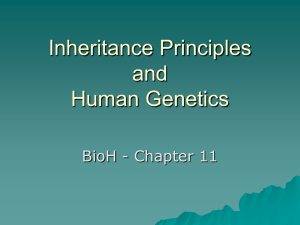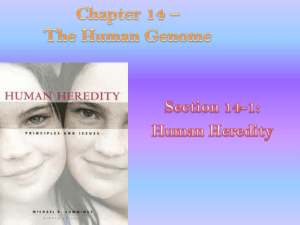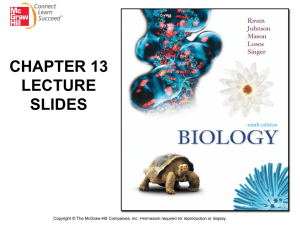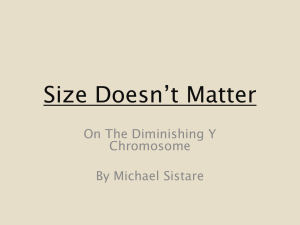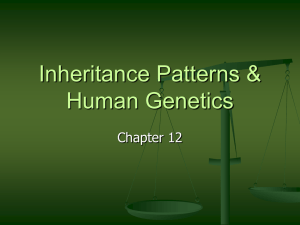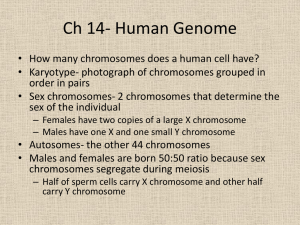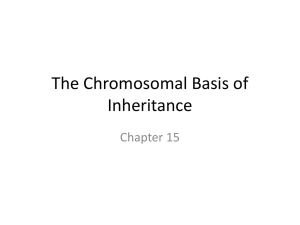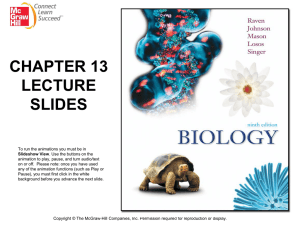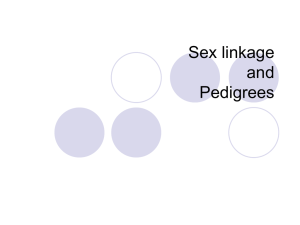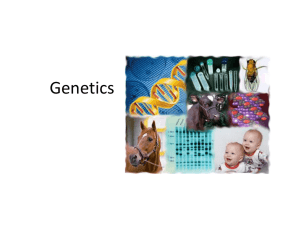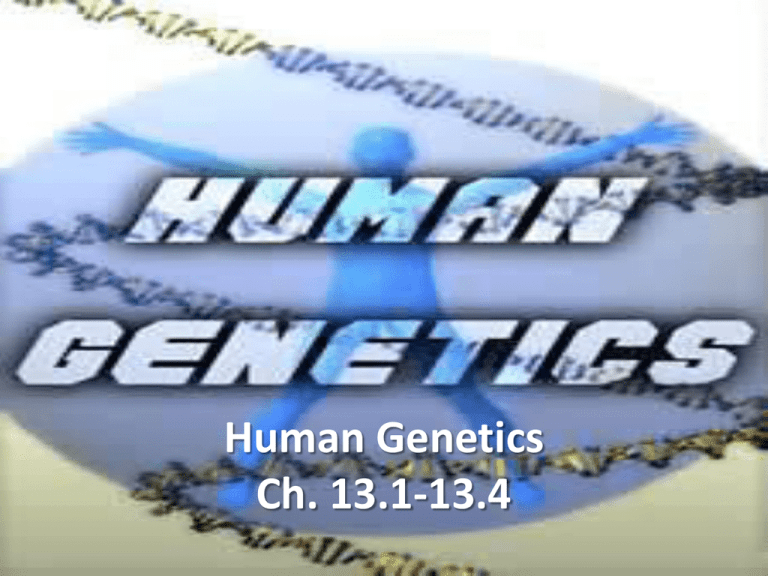
Human Genetics
Ch. 13.1-13.4
Why Study Our DNA?
• Learn the effects of mutations
• Understand how genetic
diseases are generated
• Propose possible treatments
for genetic diseases
• Identify causes of genetic
diseases
• Unfortunately, inheritance is
mostly NON-Mendelian
– The alleles for traits are passed
on and expressed in complex
ways
Genetic Linkages
• What is Mendel’s Principle of
Independent Assortment?
– Genes are separated independently
into gametes and thus offspring
• We have only 23 chromosomes,
why is complete independent
assortment impossible?
– 100,000 of genes and only 23
chromosomes to be condensed
into; some genes have to share the
same chromosome
• Genes on the same chromosome
are linked genes
• In order to study inheritance of
multiple genes, we are going to
have to map out what genes are
on what chromosomes
Mapping A Chromosome
• Morgan and Sturtevant; 1900’s
– Cross-breeding fruit flies;
Drosophila melanogaster (model
genetic studies organism)
• pr+pr+ vg+vg+ red eyes; long
wings
– “+” = wild type (normal/dominate)
• prpr vgvg purple eyes; vestigial
wings
• Expected 1:1:1:1 ratio (all
combinations of eye color and
wing type)
• Got almost 1:1 of parental
phenotypes (Red/Long:
Purple/Vestigial
• Small percent were Red/Vestigial
or Purple/Long (recombinant
phenotype)
Mapping A Chromosome
• Why a near 1:1 of the parental
phenotypes?
– Genes are linked; eye color and
wing type are on the same
chromosome
• Why the small percent of
recombinant phenotype?
– Crossing Over during meiosis;
Genes must have been switched
on homologous chromatids
• If two sections of a chromosome
are switching places, than what
can you conclude about the
percent of genes you would see
switched in an organism?
– The further away the genes are
from each other on the
chromosome the more likely they
will get switched
Recombinant Frequencies
• Of the F1 generation; 305 had
recombinant phenotypes of
the 2,839 total progeny
(offspring). What is the
recombinant frequency?
– 10.7% (305/2,839 *100)
• Sturtevant brilliantly deduced
that recombinant frequencies
between multiple linked genes
could be use to map out the
locations of genes on their
chromosome
– <1% - 50%; Why is 50% the
max?
• Progeny get either parental
chromosomes or recombinant
chromosomes (50%)
– Linkage map
Linkage Map
• Written in mu (map units) or cM
(centimorgan); map shows relative
location based on other known alleles
• Map of alleles a, b, and c:
– a-b 9.6% = 9.6 mu
– b-c 2% = 2 mu
– a-c 8% = 8 mu
• a must be far from b and c must be
between them, but much closer to b
– 9.6 mu (a-b)– 2 mu (c-b)= 7.6 mu (a-c)
– Why the inconsistency?
– a is pretty far from c and b so there may
be a double cross over sometimes
• What can we conclude about genes
more the 50 mu apart?
– They follow independent assortment (no
linkage) because 50% is highest possible
recombinant frequency
Example Map Problem
• A kidney-bean-shaped eye is produced by a recessive gene k on the third
chromosome of Drosophilia. Orange eye color, called "cardinal," is produced by
the recessive gene cd on the same chromosome. Between these two loci is a
third locus with a recessive allele e that produces ebony body color. Homozygous
"kidney," cardinal females are mated to homozygous ebony males. The trihybrid
F1 females are then testcrossed to produce the F2. Among 4000 F2 progeny are
the following:
1761 Kidney, Cardinal
97 Kidney
1773 Ebony
89 Ebony, Cardinal
128 Kidney, Ebony
6 Kidney, Ebony, Cardinal
138 Cardinal
8 Wild type (+)
• (a) Determine the linkage relationships in the parents and F1 trihybrids.
• (b) Estimate the map distances.
a) Female(kk e+e+ cdcd) X Male (k+k+ ee cd+cd+)F1= kk+ ee+ cdcd+(wild type)
b) ke crosses: k e (128) and cd (138)
double crosses: k e cd (6) and wild type (8)
128+138+6+8= 280/4000 x 100= 7% = 7mu
ecd crosses: e cd (89) and k (97)
double crosses: k e cd (6) and wild type (8)
89+97+6+8= 200/4000 x 100 = 5% = 5mu
The Amazing Drosophila
• Genes linked to sex
chromosomes also discovered
through fruit flies
• Doing a F2 cross Morgan expect
the normal 3:1 but instead he got
all females with red eyes and
50% males with white or red
eyes
• What does this tell us?
– Eye color is sex linked; X
chromosome
– Males have a 50% of getting Xw+ or
Xw; females all get at least one Xw+
so they all have red eyes
– X-linked recessive all males
progeny of a XrXr x YXR get Xr
Sex-Linked Genes
• Any genes located on the sex
determining chromosomes
– X or Y in humans
– Mapped through male/female
dependent inheritance
– All other 22 chromosomes are
called autosomes (automatically
inherited)
• Y Chromosome
– Sex-determining genes; SRY gene
makes females into males while
an embryo
– Maybe fading from existence;
may be getting smaller
– XY heterogametic
• X Chromosome
– Mostly codes for non-sex related
traits (ex. Color vision)
– XX homogametic
Too Many Xs!
• Why do females need two Xs?
– They Don’t! Two X chromosomes
would mean double the genetic
material necessary
• What does the body do with the
X chromosome?
– It randomly shuts one X down
– Creates a Barr body dense
mass of inactive chromatin
– They are copied and passed on in
mitosis but are never used for
proteins
• How can this show us Xrecessive traits?
– Dominate X might be randomly
deactivated so the X recessive is
randomly present in cells
– Female calico cats have a mix of
orange and black fur but males
are always black or orange
Following Sex-linked Traits
• Pedigree map of parents
and offspring in a family over
generations
–
–
–
–
⃝ female
males
has trait
carrier; has gene but not
trait
• Hemophilia platelets
numbers so low person often
bleeds to death from little
body damage
– X-linked recessive gene
– Rare for XhXh why?
• Most males with the disease do
not reproduce
– Lead to the Russian Revolution
Chromosomal Mutations
• Major change in a
chromosome's structure
or the number of
chromosomes in a
gamete
• 4 Types:
1) Deletion
2) Duplication
3) Translocation
4) Inversion
Deletions and Duplications
• Deletion section of
chromosome is lost
– Cri-du-chat (cat’s cry)
– Deletion from Chromosome 5
causes mental retardation and
malformed larynx
– Cry sounds like cat meow
• Duplication section is inserted
to a homolog that already has
that section
– Why can two copies allow the
slow testing of mutations?
– One mutated copy tests
adaptation but organism
basically functions normally
– Hemoglobin in humans has
evolved this way
Translocation and Inversion
• Translocation section
attached to non-homolog
– Typically reciprocal (two
chromosomes each have
translocation)
– Philadelphia Chromosome
translocation of 9 and 12;
causes uncontrolled growth in
white blood cells (leukemia)
• Inversion section attached
to original chromosome but
in the reverse order
– Genes lose function or
produce harmful/beneficial
new versions
Non-Disjunction
• Euploidy normal amount of
chromosomes
• Aneuploidy missing or extra
amount of chromosomes
– Monoploids, triploids, tetraploids,
….polyploids
• Most miscarriages (baby deaths
before birth) are aneuploidy
• Trisomy 21 and 18 develop but
live short and difficult lives
• X and Y polyploidy survive…
– XYY?
– Extra Y’s just mean more male
characteristics; no essential genes
– XXY and XXX?
– Barr bodies turn off extra Xs
Human Inheritance Patterns
• Autosomal Recessive
– RR no trait
– Rr carriers
– rr show the trait
• CF Cystic Fibrosis
– 1:4,000 births in US
– Lose Cl- channel transport efficiency
– Build up of thick mucus blocks lungs
and promotes disease
• PKU Phenylketonuria
– 1:15,000 births in US
– Enzyme cannot break phenylalanine
into tyrosine
– Build up causes brain damage
– Must be medicated and restrict diet
Human Inheritance Patterns
• Autosomal Dominate
– RR have trait
– Rr have trait
– rr no trait
• Dwarfism
Achondroplasia
– 1:25,000 births worldwide
– Only heterozygous survive
embryo development
– Defective cartilage leads to
short arms and legs; large
heads; regular sized body
Human Inheritance Patterns
• X-Linked Recessive
– XX no trait
– XXr carries
– XrXr have trait
• DMD Duchenne muscular
dystrophy
– Muscle tissue degrades; most cannot
walk or need crutches
– Dystrophin is defective; protein anchor
in muscle cells; results in tearing
• X-Linked Dominate
–
–
–
–
–
XX have trait
XX have trait
XrXr no trait
Extremely rare in humans
Teeth discoloration
Genetic Disease Testing
• YOUR TURN!
• Write a 2 page essay (12 size
arial font, normal margins) on 3
methods used today to test for
genetic diseases
– Two may come from your book
– One MUST come from an outside
source
– You essay should have details in
how the process works and the
pro and cons (good and bad
parts)
• Essay is due 12/13, in print
Homework
• Actual:
– Essay on Genetic Screening
– Fruit Fly Lab
– Apply Evolutionary Thinking
(p.280)
• Suggested:
– Test Your Knowledge (Ch. 13)
– Design the Experiment (Ch. 13)
• Test on Ch. 11, 12, and 13 on
Thursday


